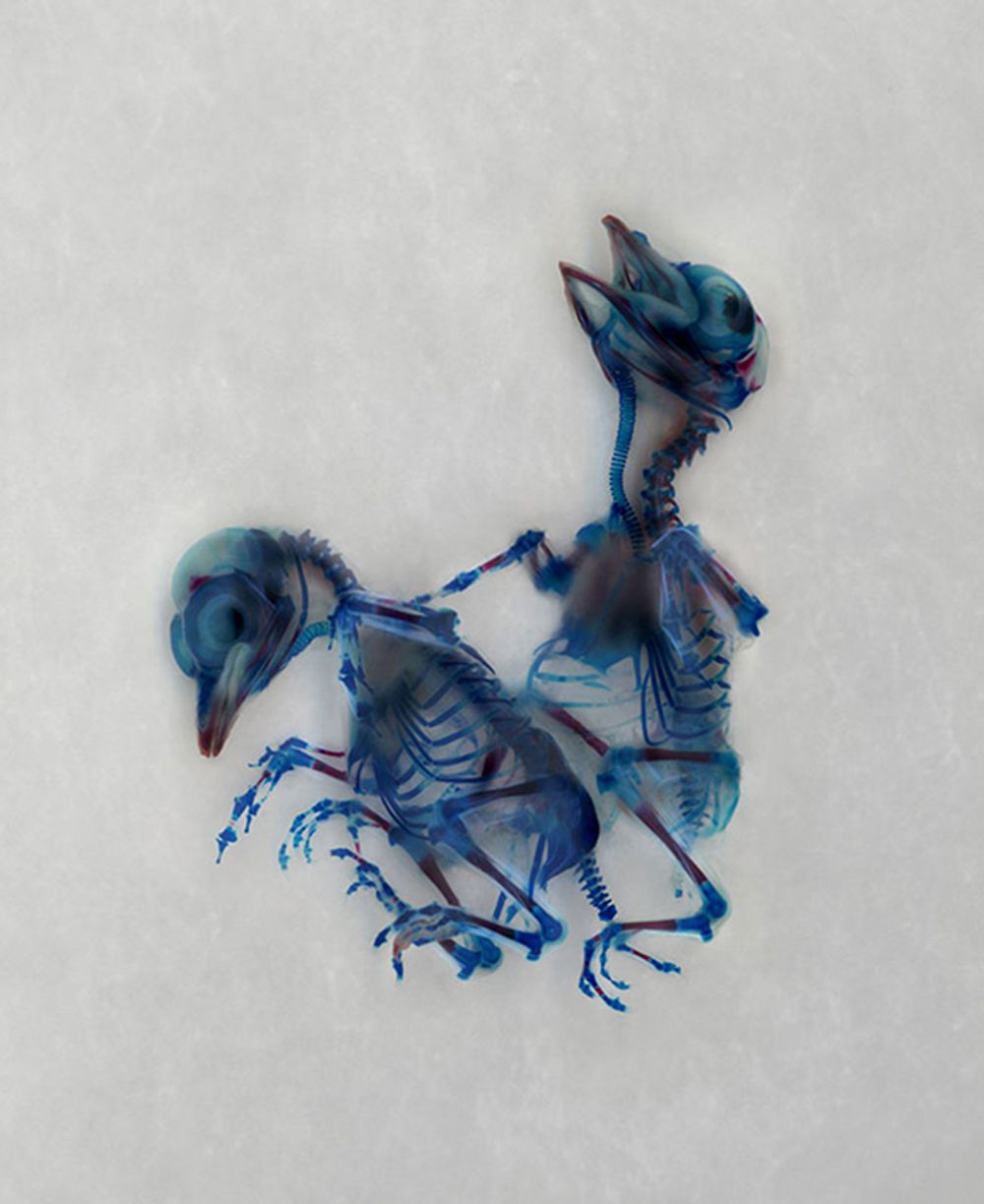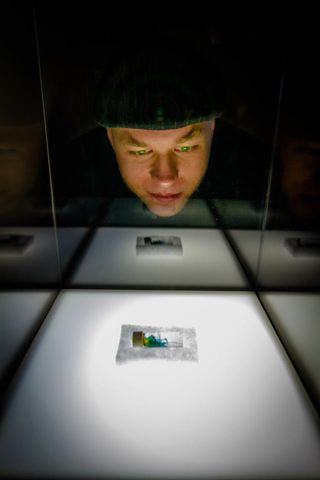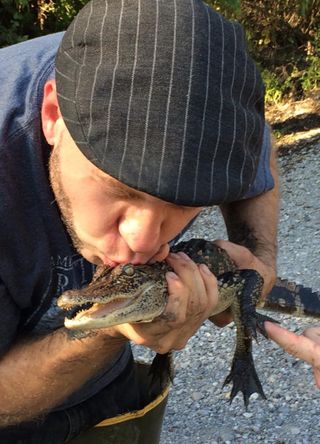
Framing the End: Extinction as Art (Interview)

Paulette Beete, NEA senior writer-editor, contributed this article as part of partnership between NEA and Live Science's Expert Voices: Op-Ed & Insights.
It is tricky to measure the number of species going extinct each year on our planet — it all depends on how many species of flora and fauna exist, a difficult number to pin down. What most scientists can agree on, however, is that the extinction rate is 1,000 to 10,000 times higher than it would be if people weren't around.
While those changes don't appear to impact our everyday lives — the extinction of a little-known tree frog doesn't change how long we wait in line for our morning coffee — the accelerated rate of extinction does hint at the ways in which climate change and other global phenomena will eventually have a significant impact on the way humans live, in terms of habitable landscapes, food supply, water resources and other crucial areas. It is this looming, possibly catastrophic change that Brandon Ballengée — an artist, biologist and environmental activist — takes as the subject matter for his art. [6th Mass Extinction? Humans Kill Species Faster Than They're Created]
Ballengée, on the faculty at the School of Visual Arts in New York City, has been active in the worlds of both art and science since he was a kid. As he explained to me in a recent interview, "I had a lab in my parents' basement and I had an art studio in our barn. . . . I was one of those kids who was constantly out catching fish and going in the stream and collecting salamanders and frogs and turtles, and then I'd bring them into the lab, keep them for a while, draw them, and then let them go."
As an adult, Ballengée's artworks and scientific research are still very much in sync. Even as he documents mutation and extinction in the amphibian world in the lab, in the studio he creates erasure works (made by manually excising elements from existing works of art) and installations that add emotional resonance to his data.
Recent projects include "Malamp," a series focusing on terminally deformed frogs, and "Frameworks of Absence," in which species that have gone extinct are excised from antique and vintage prints bearing their likenesses. Ballengée has had solo exhibits at venues such as the National Academy of Sciences, Lousiana's Acadiana Center for Arts, Ronald Feldman Fine Arts in New York City, and the Nowhere Gallery in Milan, Italy, just to name a few. Ballengée has also participated in biennales and festivals, including Prospect 2 New Orleans, Biennale for Electronic Arts Perth, the Moscow Biennale, and the Venice Biennale. Ballengée holds a Ph.D. in Ecological Understanding through Transdisciplinary Art and Participatory Biology, and at the School of Visual Arts he teaches science, biology and ecology to art students.
Below are excerpts from my interview with Ballengée, and you can see a gallery of his work in The Brutal Art of Extinction.
Sign up for the Live Science daily newsletter now
Get the world’s most fascinating discoveries delivered straight to your inbox.

Art and science are both ways to understand the world around us and within us — through the sciences, through this observational lens that is methodologically based, and through the arts, which are much more emotive and coming from a different place where you are able to describe complex sensations that can't be described by science.
When I am doing the science, when I'm doing the lab work or the field work, I start thinking about art projects. When I'm having these experiences, like literally holding a particular frog with a deformity or fish or animals in these ecosystems, my brain starts thinking about art and visuals. I want to create things to describe this experience, to give visual form to this experience. And when I'm making the art, my brain starts thinking in other directions, like what if I do this experiment because it may show us this?
My art practice and science work really inform and inspire each other, so it's literally cross-pollination, where I couldn't do one without the other. People have asked me several times, "If you had to choose, would you be an artist or a scientist?" I just wouldn't be able to do either without the other because they are just the way my brain works. It's total cross-pollination.
I'm quite interested in that kind of optical sensation that occurs when you see an artwork and it touches you or moves you or captivates you, engages you. It's tremendously powerful. I had this experience growing up in central Ohio, for the first time, when I was 12 or something, going to the Columbus Art Museum and seeing paintings by Robert Motherwell, and Franz Kline, and Willem de Kooning. I just remember sitting in front of this Motherwell and just being completely blown away. It was so visually powerful that it completely rearranged my perceptions. Then I became a terrible teenage abstract expressionist. It was horrible. But I think that power is a really important means to reach people in a way that's not easily quantifiable.
There's something very special about visual art. It has this ability to translate to people all over, from different age groups and different parts of the world. In science one has to be very detached, to be as objective as possible and just let the data speak for itself. Whereas in art you can be coming from this idea of wonder in a very different way that can be used to captivate audiences. To me it is fundamentally important that art remain open to the opinion of viewers and not just illustrate science. I am actually trying to captivate and engage them to the point that they want to start asking their own questions and have some kind of response to the individual pieces.
We have a rich history of art that's dealt with ecosystems and environmental issues especially in the U.S. since the '70s. Arguably you can say that some of these ecological issues were raised in artworks from the 18th and 19th century. So it may be that ecological issues have been part of this conversation in visual art for a really long time. There are real pioneers that start to emerge in the '60s and '70s, people like Helen and Newton Harrison, and their important work with different environmental issues as well as urban farming issues and aquaculture as art for the first time, (which actually was funded by a scientific organization but it was an artwork that produced science). Also people like Joseph Beuys planting oak trees and swimming in bogs in an attempt to raise awareness about these sensitive ecosystems; Hans Haacke doing this great water filtration piece that highlighted the impacts of pollution on the Rhine River in Krefeld, Germany; and Mierle Ukeles and the conversation about this idea of waste and how this percolates out into all kinds of different cultural aspects, such as how we view one another based on the kind of jobs we have. So there's this rich history that directly correlates with the environmental movement. It's only natural that artists have been creating works that speak about these environmental issues because they are so crucial to the survival of so many species, but also inevitably our own.
Increasingly we are starting to see more and more exhibitions internationally with environmentalist art or ecological art. It's a growing movement. Certainly with all of the new knowledge that's being sent out to society at large, many artists are dealing with issues such as climate change. These issues are so pertinent and critical that more and more artists are doing it. Now we see more and more museums and galleries and universities offering more exhibitions of this kind of work and more programming that involves this kind of work, like workshops and courses in combined art and science. I teach biology and ecology, pure science courses, in an art school here in New York City — the School of Visual Arts — and the classes are completely full. Young artists are really interested in these ideas. We are becoming much more environmentally aware as a global culture.
As a biologist, the reason I got into amphibians in the first place is because of this global crisis that is happening with their populations. I wanted to be a fish guy but I ended up being a frog guy because there's just so much to figure out. Upwards of 40 percent, maybe even 43 percent, of the known species are considered in decline, have declined, or are already extinct! It's a kind of crisis that's occurred within my lifetime, within 40 years. The first big papers about amphibian extinction started to come out in 1989 and then in the early '90s. They were thinking it was maybe 20, 25, 28 percent decline rate and each year getting worse. It's not only tragic from a species level, but it's horrifying because they've been here a really long time and they've lived through several mass extinction events.
They used to call them "the canary in the environmental coalmine,” which is actually not
that good of an analogy. What they are instead are the ones that can survive an awful lot — if they start to disappear, it's because the environment is really under such an assault that we are seeing a much larger potential multi-species problem or a whole climate problem. It's hard not to focus on the idea of extinction because you are constantly concerned with what you are finding in the field. You get this sense of void where they are disappearing, and there's very little global effort being done to stop it nor even slow it down. I respond to these issues through a body of work I refer to as "Malamp." With the "Malamp" works I try to give individual presence, visually, to the terminally deformed frogs I have found at locations around the world. This takes the form of unique printed portraits in "Malamp Reliquarie"s and sculpturally in the installation "Styx" whereby I exhibit the actual specimens on specially designed floor-standing light-boxes.

A real focal point for a lot of my artwork is this kind of disappearance. How do we give visual form to extinction or this kind of void that's left when a species disappears? So in the beginning I was really experimenting through installations — and I still do — where specimens are displayed as silhouettes to metaphorically recall this idea of something that's there but disappearing. In my installation "Collapse," which dealt with the impact the Gulf of Mexico food-chain following the 2010 Deepwater Horizon oil spill, empty jars represented species that are already in decline from the Gulf.
Then there's this whole other series called "Apparitions," which are either extinct species (of birds usually) or other taxidermy that have been lost in museum collections because the data on the specimen has been misplaced over time. They are there in the physical-object sense but lost in a science collection and are strange lingering artifacts almost ghostlike. Also I would get prints from old nature magazines or books with pictures of extinct species, and then I'd blacken them with Japanese ink. Still, the darkened forms looked more like a positive than a negative. At one point it dawned on me that there was this piece by Robert Rauschenberg where he erased a de Kooning drawing. I started to try to erase them, and that didn't really work because there was still evidence of them there, so it wasn't a good analogy for the extinction. Then one day I cut the image of a passenger pigeon out of a page of an old field guide and it worked perfectly and became part of the "Frameworks of Absence" series. But there was a whole other host of problems to deal with.
Ethically how do you justify this? I am destroying historic artifacts, although these materials are all from editions. I wouldn't do it, for example, with an original John James Audubon painting or from any other unique work of art. But I would do it with one of the elephant folio editions, as there are multiples and other copies exist. Even then it took me years of internal debate before I cut the first actual artifacts. But it is essential that the "Frameworks of Absence" be created from a real historic artifact that was around at the moment in time the real animal was fading into extinction. Once the correct artifact is found, I scan and document it to create an archive. Then I remove the depiction of the animal by cutting them out with Exacto blades while wearing watch-maker glasses. This depiction is then burned, and I place the ashes into black glass funerary urns etched with the name of the lost species. I then ask people to scatter the ashes. Scattering the ashes is a transformative experience — my hope through this action is that participants become connected to that lost species and will work towards helping to stop further extinctions.

Finding the correct artifact is difficult, and even researching the lost species themselves is a challenge. Even in the United States, there's not a single source that lists everything that's gone extinct here, because we just don't know. There have been so many extinctions, depending on where you are looking — there is one estimate that there are more than 700 species of snails that went extinct in Hawaii, alone. This has been ongoing for more than ten years, trying to compile this database of extinct species, trying to figure out when they went extinct, because unless there's an historic account, like say the extinction of the last Great Auk, which was this amazing bird, it is difficult to know what has been lost. Species like the Great Auk, Eastern wood bison, California grizzly bear, and others, we know about their deaths because the people took credit for it — they were very proud by the fact they killed the last ones, which seems so bizarre now.
So you have to do the research to learn when the species went extinct and then try to find depictions, because for a lot of the species there aren't any. They just were there, and then they were gone. And some of the time they are only depicted in graphic forms, in scientific papers, so I utilize those now too. Initially I was working just with prints by John James Audubon, who I always considered such a hero, such an interesting and important artist and scientist and educator. I started with Audubon, and then I expanded out to 60 or 70 different artist-scientists as the body of work has continued with prints from the 1600s to today. Right now, I have mostly been focusing on the Americas, North America, South America, the Islands, and have included Hawaii. Over a decade I have been collecting the prints, a lot from Europe while I was working there. So that was a whole other side to this project of trying to find a depiction, and then sourcing the prints, and then financing the project.
We are at a really interesting moment in cultural history. There is so much more art and science programming than ten or 20 years ago. I remember when I first started showing my work in New York in the late '90s. I was criticized because people were saying, "This is science and not art." And then from the science standpoint, scientists would look at it and could clearly see that it wasn't science; it was just informed by scientific observations. Now it's really changed. There are art-science programs popping up all over the country and all over the world. There is a much larger trend towards transdisciplinary thinking or moving beyond the kind of secular thinking that we have between disciplines.
It's an overused analogy, but the idea of just asking a question through a different lens is so important. I find when I'm working with the public on what I call "eco-actions," which are citizen-science field trips or participatory biology field trips where I'm asking people to come and help me do the fieldwork, they are making observations that are completely novel. They are asking these questions so out of the box that it makes me think about things differently. I can see firsthand the creative benefit for that from a scientific standpoint and from years of working with other scientists within this realm of art and science. It's common knowledge that people do benefit from this kind of cross-pollination and get inspired. Certainly artists are becoming inspired and influenced by science, and vice versa. Increasingly we are seeing laboratories and research facilities that want to invite artists because it's just going to be adding a new layer of creativity. Likewise, environmental organizations are increasingly reaching out to artists that have creative input. I think that's really exciting.
Follow all of the Expert Voices issues and debates — and become part of the discussion — on Facebook, Twitter and Google+. The views expressed are those of the author and do not necessarily reflect the views of the publisher. This version of the article was originally published on Live Science.












